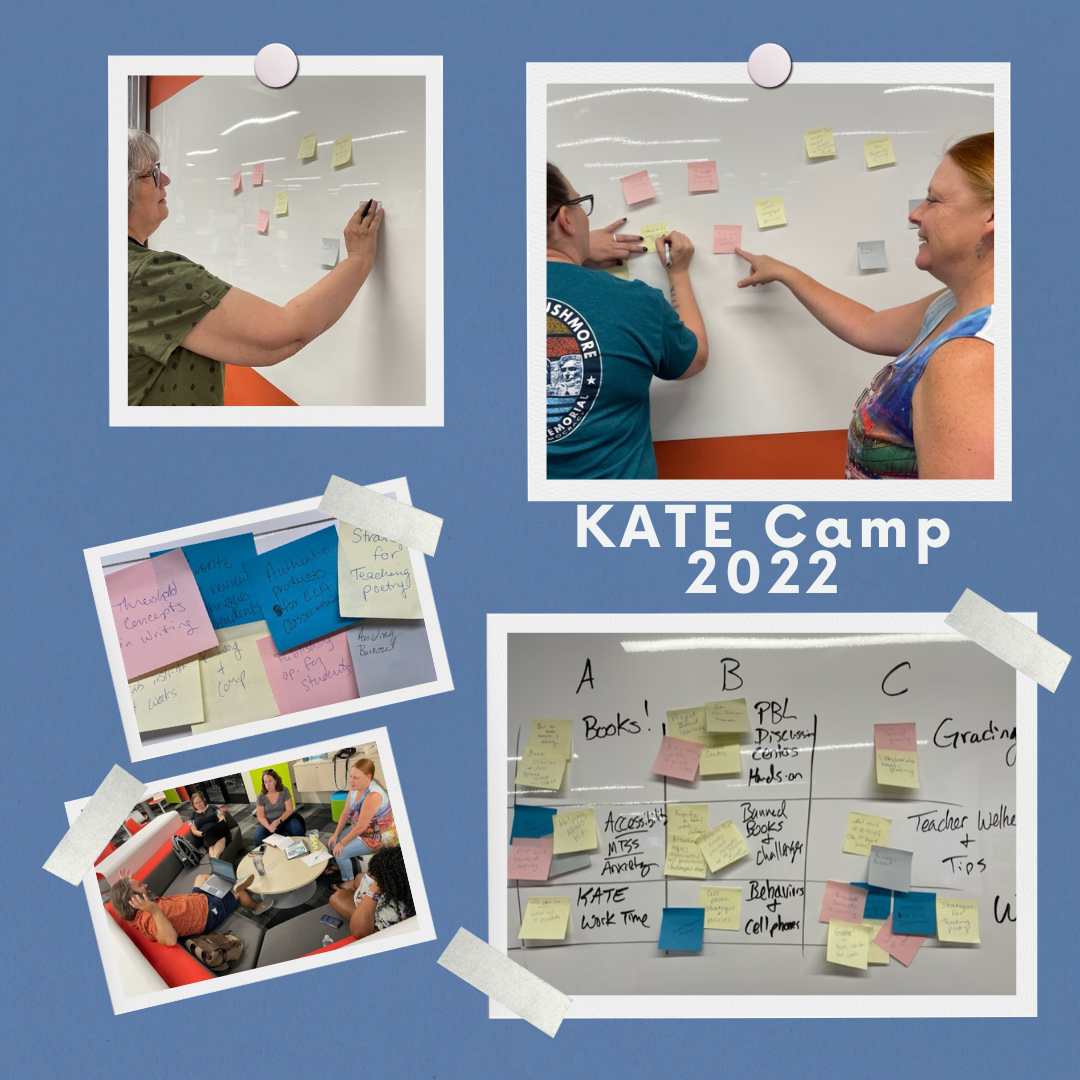 When you hear the title KATE Camp, what comes to mind? Tents? Fishing? Campfires? Mosquitoes? While all of that might sound fun to some of you, none of it pertains to KATE Camp. At least not yet. Nowhere does it state that KATE Camp can’t happen at a real life campground. This year's KATE camp, however, took place at Johnson County Community College where there was plenty of air conditioning and no need for bug spray. But what is KATE Camp? Only the best summer PD ever. Think of it as an un-conference. ELA teachers from across the state gather to learn from each other. The agenda is not set ahead of time. Instead, attendees determine the topics and lead their own learning. And another thing–KATE Camp is free for members. Free! Honestly, what better professional development can you wish for than authentic conversations with expert teachers about your chosen topics. Here are some highlights from a few of the breakout sessions. TEACHING TIPS When ELA teachers congregate, you know great teacher tips will start flying. One of the most popular sessions involved sharing effective strategies for teaching writing. If you have any questions about using these in your classroom, ask in the comments or in the KATE Facebook group. Ted Talks Ted Talks are an engaging way to introduce students to topics they might not have otherwise considered. The speakers are professionals and the topics are relevant. The specific Ted Talk mentioned at KATE Camp was Aleph Molinari’s “Let’s Bridge the Digital Divide”. It’s a nine minute video arguing for a specific way to help communities living in the digital divide, or the digital abyss, as he calls it. This Ted Talk can be used to introduce an important topic but also it can be used as a stellar example of logical reasoning. As students break down Molinari’s argument, they will understand how to create their own logical lines of reasoning. Undoubtedly, they will also learn about problems facing cultures outside of their own. Please share in the comments for this post which Ted Talks you have found useful in your classroom. Include your grade level and tips for engagement. Public Posters The basic concept is to pre-write in groups, record it on posters, and hang the posters on your classroom wall as tools for all students. For example, if students are writing a character analysis, assign each group one character trait. The group will record on a poster cited evidence for that trait and commentary. As students individually write their essays, they can check out the posters for evidence ideas and for examples of commentary. They can’t plagiarize the commentary, but they can certainly let it inspire them. Additionally, any cited evidence on any poster is fair game. Threshold Concepts in Writing In the book Naming What We Know: Threshold Concepts of Writing Studies, authors Linda Adler-Kasner and Elizabeth Wardle define threshold concepts as “concepts critical for continued learning and participation in an area or within a community of practice” (2). KATE Camp participants discussed the idea of writing as its own area of study and what foundational concepts are necessary to study writing as opposed to using writing as a way to study other areas. Only in a room full of passionate ELA educators can you find this kind of meaningful discussion about the art and science of writing. TEACHER WELLNESS AND RELATIONSHIPS It’s no surprise to you that we teachers have felt the impact of the pandemic, especially the attempts to engage our students meaningfully. One of our KATE Camp sessions focused on this very thing. Building Relationships From the Start First, as surely you know, you have to start off on the right foot. Instead of reading over the syllabus the first day–usually resulting in snores and stares, it’s better to get to know your students first and build that rapport. Some joke that you have to let the kids see a little of your “crazy,” y’know, just to make them wonder. Really, though it comes down to letting them see you as more than a teacher. When they can relate to you, and they can tell you see them as more than a student, it helps build that relationship, which goes to improve classroom management. Boundaries for Wellness Probably one of the most important lessons the pandemic has taught teachers is the value of boundaries. If you’re anything like me (Amanda), you probably hold “teacher” as a part of your core identity. You can regularly be seen in your classroom outside of contract time, prepping and grading away. But if you are trying to show your students you are human and there is more to you than being a teacher, you definitely have to believe that for yourself first and foremost. Setting boundaries is so important to not only your identity, but it can also be vital for your own mental health, especially when we so often carry the emotional load of our students. So during this session, participants discussed some of the best boundaries they have implemented to support a healthy work-life balance. These included: answering emails only during contract hours; taking and making calls only during contract hours if at all possible; grading at school–when this is possible, but let’s face it, we’re English teachers; making sure we find healthy ways to unload the mental stress the job can leave us with such as talking to a counselor, writing, and taking time to relax without feeling guilty. BEYOND THE “UN-CONFERENCE” Phenomenal Art Museum Experience The Nerman Museum of Contemporary Art is located just steps away from where KATE camp took place. The museum is deceivingly large and spacious. A teacher looking to suck every last ounce of indulgence out of summer could get a little lost. Shinique Smith’s STARGAZERS exhibition pulled us into a mesmerizing world of fabric, clothing, collage, and sound that explored the expression of identity. Upstairs, Kehende Wiley’s Alexander the Great (Variation) brought a feeling of empowerment. Kehende Wiley is especially famous for what is called “street casting”. He discovers young, black men from the streets and paints them in the fashion of Renaissance masterpieces but maintains their modern attire. You can read more about his amazing life and work on the website, TheArtStory.org. Literature and art collide in Tim Rollins’ The Adventures of Huckleberry Finn (mixed media on canvas). The wall-sized art is a repainting of one of the original book illustrations commissioned by Mark Twain. From across the room, the painting is quite powerful. Upon closer examination, the viewer can see that the canvas is made from pages of the novel. The work was created with the help of a group of Kansas City teens. Executive Board Meeting Before the “un-conference,” the executive board met for the summer meeting. One of the discussion items was the various needs and different changes to our upcoming Fall Conference. (Insert shameless plug for one of the best experiences KATE has to offer!) Thanks to the efforts of various board members, this year is shaping up to be an amazing gathering with a focus of ELA as Art & Science. Keynote speakers are Jeff Zentner, author of The Serpent King and Tabitha Rospory, 2020 National Teacher of the Year. Save the dates, October 28 and 29, 2022, a stay tuned for registration information. In the meantime consider sharing your own expertise in a breakout session. You can use this link to submit your session proposal. The board meeting was also a time to discuss the future of our organization. We are excited for some new opportunities and refreshing some old ones. One opportunity is a newly created board position, the public relations chairperson. The official description for this position is as follows: Public Relations Chairperson(s) shall be responsible for promoting the Association and recruiting new members by supervising (1) the production of informative media about the association and (2) the distribution of these media to schools, universities, and other institutions interested in the Association's mission; (3) media shall include print, electronic, and social media of the organization. This position is a great way to practice your content creation and marketing skills. Since it’s new, you can make it your own! Please nominate yourself or someone you know who would enjoy getting the word out about KATE. Use this link to nominate KATE members for this and other positions. Additionally, the Diversity and Inclusion Committee is looking to expand. To become part of this important and energetic committee, tell us in the comments below or in the KATE Facebook group. Krystal Jordan will reach out to you. FINAL THOUGHTS In conclusion, the best part of KATE Camp is the opportunity to get together with like-minded peers. KATE Camp usually happens in July, so send yourself a reminder to register for it when you see the announcement, probably sometime in May. As summer vacations and campouts come to end, KATE is revving up for an exciting 2022-23 school year. Remember, ELA is for everyone, so check your email for the monthly newsletter and invite your teacher friends to join our membership of exceptional teachers. AUTHORS: Deborah McNemee is a veteran teacher of the high school ELA classroom. This year, she’s starting a new teaching adventure as a middle school instructional coach. She loves classic lit and is a sucker for a good retelling. Outside of the classroom, she manages the Keeping Classics teacher blog and searches for quirky, small-town Kansas museums to tour. Her modern debut YA novel, Just Daisy: A Gatsby Retelling is available through Amazon and Watermark Books. Amanda Little is an ELA teacher for upper level high school. She’s taught everything from drama to speech to college composition classes. This year she is starting in USD 305 at Salina Central after teaching for several years in a rural school district. When she isn’t teaching, you can find her at her part time job at the Salina Public Library, spending time with her family, crafting, or reading and writing poetry. She’s working on a poetry manuscript, and you can find some of her poetry in Trees in a Garden of Ashes and CHAOS: A Poetry Vortex (2020, Local Gems Press).
0 Comments
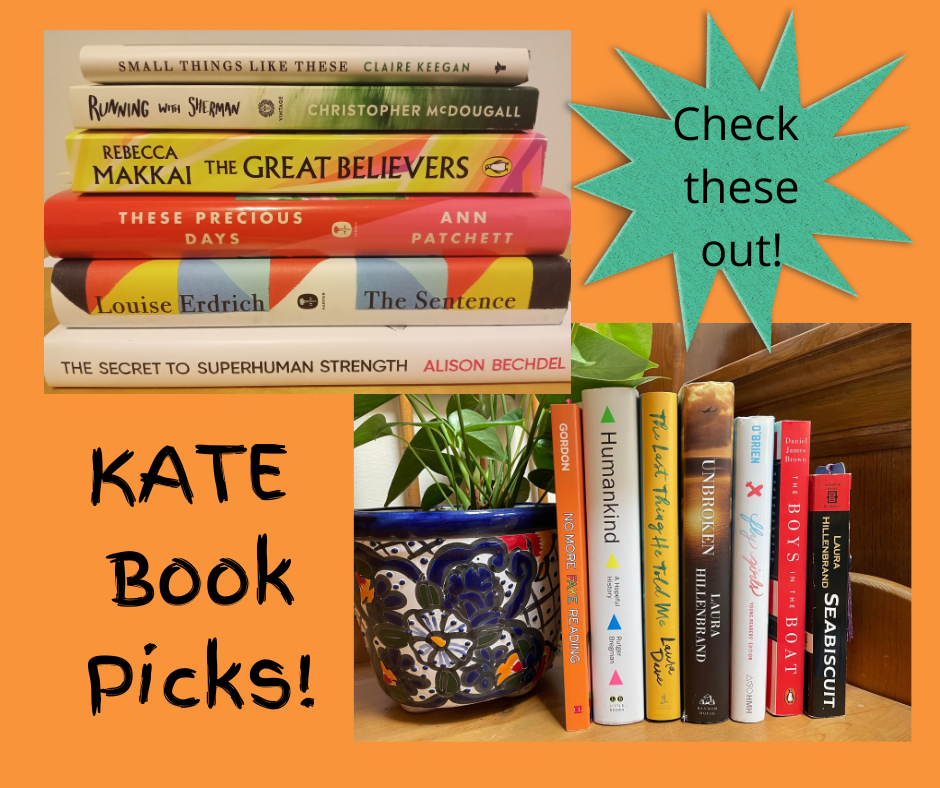 Here’s a Jeopardy question for you. Category: Fun Things for FREE (with your KATE membership). Answer: A discussion focusing on 49 different books ranging from graphic memoirs to poetry. Question: What is the KATE summer book tasting? If you love books, and we know you do, you would have loved the KATE summer book tasting. Throughout the year, KATE hosts similar events such as book clubs and CoffeeEdu Zoom chats. You can learn about upcoming get togethers in the KATE monthly newsletter, on the KATE website and through our Facebook group. These casual meetings help us get to know each other, lead to collaboration, and create wonderful teacher friendships. The June 11th summer book tasting also provided a huge list of book recs. You should know that this list of forty-nine titles was generated in about an hour by four teachers discussing our reading experiences. The topic prompts for this Zoom chat included books we studied in class this past year, our personal reads for the summer, and books we are excited about for next year. For the most part, we stuck to the plan, but as you’ll see, the list is varied and spans quite a range of genres. After a few feeble attempts to organize the list for your perusal, we gave up. We free-associated this list with the energy of a teacher-tired summer brain coupled with stream of consciousness and puns. We hope you enjoy these books as much as we do! Let’s start with the King and the Dragonflies (by Kacen Callender) and also Lord the regular housefly, I guess. Or maybe it’s an island fly. Nevertheless, it’s Lord of the Flies (by William Golding). Then there’s Damselfly (by Chandra Prassad) and Fly Girls (by Keith O’Brien). Which leads us to Girls of the Atomic City (by Denise Kiernan) who might Jumpstart the World (by Catherine Ryan Hide). Picnic. Lightning. (by Billy Collins), Things Fall Apart (by Chinua Achebe), Unbroken (by Laura Hillenbrand), and Bands of Mourning (by Brandon Sanderson). Followed, or maybe preceded by Twelve Years a Slave (by Solomon Northrup) and 1984 (by George Orwell), which is quite the Saga (by Brian K. Vaughn). Let’s segue into American Born Chinese (by Gene Luen Yang) and Vietnamerica (by GB Tran), and then a little Reading Lolita in Tehran (by Azar Nafisi). Speaking of Lolita (by Vladimir Nabokov), that’s a book and half, isn’t it? Even if you haven’t read it, you know the name. It’s not a name most of us would like to be called. Even Lolita might demand, Call Me By Your Name (by Andre Aciman). Or any other name. How about Antigone, (by Sophocles) or The Great Gatsby (by F. Scott Fitzgerald), or Felix Ever After (by Kasen Callender), or George/Melissa (by Alex Gino)? How about Elizabeth Bishop (Complete Poems 1927 to 1979)? Persepolis (by Marjane Satrapi) made our list, along with Running with Sherman (by Christopher McDougal). Whew. We’ve only covered half, so far. Oh well, you know what they say? No, you don’t? But you might know They Say/I Say (by Gerald Graff and Cathy Birkenstein), or Speak Up!: Speeches by Young People to Empower or Inspire (by Adora Svitak), or The Last Thing He Told Me (by Laura Dave). Which leads to They Called Us The Enemy (by George Takei), Rhetorical Agendas (by Patricia Bizzell), Understanding Comics (by Scott McCloud), No More Fake Reading (by Gordon Berit), Games of Deception (by Andrew Maraniss), Nothing Ever Dies by Viet Thanh Nguyen), and finally, for the love of all things bookish, Can We Talk About Something More Pleasant? (by Roz Chast). Yes, something more pleasant like Book Love (by Debbie Tung), The Perfect Horse (by Elizabeth Letts), Those Precious Days (by Ann Patchett), When the Moon Was Ours (by Anna-Marie McLemore), Years of Wonders (by Geraldine Brooks), Infinite Hope (by Ashley Bryan), Humankind (by Rutger Berman), and even The Dutch House (by Ann Patchett), which we have no idea whether it’s a nice place or not, but it sounds lovely. Because it is summer, maybe we should also talk about Why We Swim (by Bonnie Tsui), The House on the Cerulean Sea (by TJ Klune), Seabiscuit (by Laura Hillendbrand), The Boys in the Boat (by Daniel James Brown), or Cannery Row (by John Steinbeck). Row…see what we did there? Are you entertained yet? If you kept count, that’s forty-nine. We wish with all our hearts that someone had mentioned a book with the word cheese in the title because that word might sum up this post better than any others. In fact, why not round it up to an even fifty? Because our book tasters were all secondary or higher educators, we didn’t discuss any elementary level books, so we’re adding one. It is a favorite for younger kids. Everyone should experience it at least once, The Stinky Cheese Man (by Lane Smith). We understand that we have tortured through this blog. You deserve a reward for sticking it out. Your reward is not to move onto the Double Jeopardy round in hopes of winning thousands of dollars, though. No, your reward is better than that. We asked the book tasters to choose a couple of these tasty morsels and dive in a little deeper for you. And yes, we mixed our metaphors. It’s summer. We're allowed. Read on for the morsel diving. For Nathan Whitman, KATE president: For my own teaching and improvement, I'm going to be looking at "They Say / I Say" (Graff and Birkenstein), which is a text on how to frame and learn argumentation through extensive modeling. As it's my first year teaching AP Language and Composition, I think it'll be handy for my students to have a toolbox of linguistic frameworks as they work towards the end of course exam. Additionally, for my Pre-AP English 10 students' future, I'm excited to further read more of Speak Up! (Svitak) and its speeches by teenagers. I hope it'll help me see the world more through my students' eyes and find ways to help them develop rhetorical argumentation skills on topics that are relevant. It'll be my first time including Chinua Achebe's Things Fall Apart in Pre-AP English 10, so that's also on my to-read list for the summer, and I'm looking forward to reading it from the lens of a tragedy, as KATE Summer Book Tasting attendee Steve Maack recommended. I hope that it'll not only unlock the text for myself but also for my students. For myself, summer is the time for creative writing, poetry, and whittling away at the to-read list. For June, I'm trying to work through as many LGBT+ texts as possible. My present reading is Call Me By Your Name (Aciman). It's always fascinating to see differences from film to text, and one thing that surprised me within the first two chapters is how the protagonist is probably bisexual. The film depicts him more as just angsty and using girls for cover. My bedtime read is The Bands of Mourning (Sanderson). If I'm to keep up with the prolific Sanderson, I've got to read at least a few of his books per year. He's giving Stephen King a run for his money on interconnected universes and characters. And I thought keeping track of all of my students' ever-changing relationships was difficult! To fit in some inspiration for my poetic muse and knock another queer writer off the list, I've also decided to revisit a text assigned in college by Elizabeth Bishop. Since we only read a few of her poems in class, I'm enjoying reading through the full compendium of her work. From Katie Cramer, Kansas English Editor Kacen Callender is the author of several award-winning middle-grades and young adult novels, including Felix Ever After and King and the Dragonflies, which won the National Book Award for young people’s literature in 2020. Callender identifies as Black, queer, and transgender and writes about these intersecting identities in their work for middle and high school readers. They don’t share a lot about themselves on social media, but you can learn more about them and their books at KacenClaendar.com. From Deborah McNemee, KATE Blogger The complete title is Games of Deception: The True Story of the First U.S. Olympic Basketball Team at the 1936 Olympics in Hitler's Germany. We added it to our World War II non-fiction book circles a couple of years ago. Students loved it so much, we had to double our inventory. This book does a lot. It tells the story of the invention of the game of basketball, it relates instances of racial and gender injustice associated with Hitler’s Olympics, and also chronicles the exciting journey of a few boys from McPherson, Kansas as they journey to Germany to make sports history by becoming not only the first US Olympic basketball team but also the first gold medal winners for that sport. Any book that can engage students with these important concepts is a good one. Here’s something even better, I happen to know that the author will video chat with your class. This blog is full of goodness but very long, so we’ll end it. Thank you for playing. For more book recs, follow the KATE on Goodreads. By Peter DeVries, Claudia Esparza, Jolynne Fisher, John Franklin, Steve Maack, Brittany Rubin, & Kiara Sosa-Suarez At the 2021 KATE Conference, I (Steve Maack) led a session about reigniting our teaching passions and reemerging from pandemic isolation following the last 20 months. I began with a piece by an incarcerated former student, Alex Tretbar, who published a piece in KATE’s journal, Kansas English (vol. 102), called “‘A Pair of Ragged Claws’: Poetry and Pedagogy in Prison.” We looked at some of Alex’s poetry (from which the title of this collaborative poem comes and can be found in “A Pair of Ragged Claws”) and at some poems by Jimmy Santiago Baca, a poet and memoirist who learned to read and write in prison. Alex started a poetry study group in the Oregon prison where he lives, and just before COVID led to a lockdown, he had proposed his poetry study group write a renga, a style of Japanese collaborative poetry consisting of alternating 3-line and 2-line stanzas. In Alex’s honor, I proposed that the attendees at the “Sing Something Sideways” conference session write a collaborative poem to be shared with all of KATE, and the result is below. I provided the opening lines of the renga in the session (an honor traditionally bestowed upon the poet who gathers their collaborators), and discussed renga format, but everything else in the poem comes from the contributors listed above. I provided only light editing to make pronouns and verb tense consistent and to try to order the submissions into something that seems whole. Individual line credits have intentionally been left off to emphasize the collaborative nature of the poem. I could not be more pleased with the result, both as a collaborative exercise and as a poem in its own right. My thanks and congratulations to Peter, Claudia, Jolynne, John, Brittany, and Kiara for attending my session at the KATE Conference, but also for sharing their beautiful lines of verse and giving me permission to share them. Here’s what we came up with: “Sing Something Sideways”: A Poetic Collaboration for Reemergence We awoke one day, In nightmare solitude, sad Glow of filtered screens. A cracked-concrete world where the Cold sun burns with wind unleashed. Isolation -- Alone and yet not alone, Surrounded day in and day out by chaos inside, Searching for, Longing for the peace of the outside once more. We fearfully stagger, Pursuing a light That scatters across the cage. Filtered, fractured, sifted, lost, Shelved until a time unknown. Burning rays of optimism -- Seclusion infringes on the need to be Absolute and free. Comets, stars, and crescent moons Grace the path in purple chalk. Months in agonizing isolation Begging for just a glimpse Of connection. Sideways across a window A sunbeam beckons us out. Barred from grasping its glow It dances — It taunts. The glare swallows the oxygen, Leaving us empty with our solitude. Listen to our poem We want to read this aloud We want to make you hear us! Pieces of broken marble Joined in hues of blue and gold. We finally re-emerge, Igniting feelings of warmth, Together again. About the Author 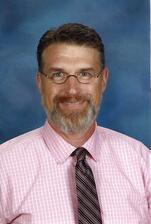 Steve Maack is a National Board Certified Teacher and English department co-chair at Wichita High School East. He is a past president of the Kansas Association of Teachers of English and just completed his thirtieth year teaching in the Wichita Public Schools. Steve can be reached at steve.maack@gmail.com or on twitter, @stevemaack. By Deborah McNemee NaNoWriMo What in the world is NaNoWriMo? Is that even a word? If it is a word, how do I pronounce it? If I can’t pronounce it, why would I want to partake in it? Just like its unique title, NaNoWriMo can bring on skepticism, curiosity, and fun. By the way, it’s pronounced nan/oh/rye/mo. Think Mork and Mindy’s nanu nanu with sort of a twist. If that’s not enough to convince you of its fun factor, you should also know that it stands for National Novel Writing Month. What isn’t fun about that? NaNoWriMo.org explains the program this way: “NaNoWriMo is a 501(c)(3) nonprofit that believes in the transformational power of creativity. We provide the structure, community, and encouragement to help people find their voices, achieve creative goals, and build new worlds on and off the page.” A more practical description is that NaNoWriMo is an online community that facilitates your writing goals. Every November, writers around the world join to motivate and support one another. A lot of writers use it as a words-on-paper sprint, as the official NaNoWriMo goal is 50,000 words in thirty days. However, members can also set their own monthly, weekly, or daily goals. Whatever the goal is, NaNoWriMo provides all the support you need to get ‘er done. There’s an online tracker and digital rewards along the way to help you stay motivated. You’ll find pep talks. You can join geographic or genre based communities. Oh, and if you hit a snag in your writing, you won’t stay stuck. They offer writer’s block busters to take care of that. Now, I know what some of you are thinking. (This is where the skepticism sets in.) The idea of writing 50,000 words in thirty days is daunting. For some teachers, even the idea of writing everyday is daunting. I hear you. I agree. However, think of those moments in your classrooms when the energy was palpable. Everyone was engaged and united in a goal. Sometimes, the outcome was remarkable. Sometimes, though, the goal wasn’t quite met. Was the energy and engagement any less exciting? Were lessons still learned? Was motivation still moving? Were memories made? If you’ve been longing for an escape, join us. If you want to try something new, join us. If you are curious, skeptical, fun-loving, daring, join us. You never know what might come of it. After all, NaNoWriMo is responsible for the drafts of novels that were later published, such as Water for Elephants and Fangirl. Honestly, though, even if no big publishing deal comes of it, we all know the benefits of daily writing. If nothing else, join us for the camaraderie. Or do it to set an example. NaNoWriMo Young Writers Program In addition to their adult program, NaNoWriMo also has a program for students. In fact, NaNoWriMo Young Writers Program curriculum is taught in over 5,920 classrooms. Young writers have a goal of 30,000 words in a month. However, just like their adult counterparts, they can choose any word count to work towards. The Young Writers Program curriculum comes with a free downloadable workbook and teacher instructions. For about ten bucks, you can purchase a classroom kit that includes a writer's emergency pack, motivational stickers, and a progress poster. KATE member Amanda Little uses the NaNoWriMo Young Writers Program curriculum in her highschool ELA classes. Make sure to attend her breakout session at 3:00 on Friday, November 5th at the Fall KATE Conference. She’s saving all the best teacher tips and tricks to share with you there. KATE Writing Group - Online Writing Sprints Maybe you are thinking that this all sounds very intriguing but you aren’t quite ready to dive into the deep end this year. No problem. KATE has a compromise for you. For the month of November, KATE is hosting a series of online writing sprints. Writing sprints are exactly what they sound like. We meet via Zoom, set the timer, and write. We’ll provide prompts for those who need it, but feel free to write whatever is on your mind or heart. These sprints are for all KATE members whether or not you are participating officially in NANoWriMo.The sprints will happen on Sunday evenings at 7:00, November 7, 14, and 21st. Sign up for Zoom access on the KATE website. For more information about NaNoWriMo, go to NaNoWriMo.org For the Young Writers Program, go to ywp.nanowrimo.org. About the Author 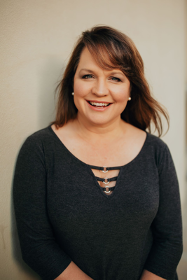 Deborah McNemee teaches at Andover Central High School where a culture of reading is alive and well. She creates a culture of reading with her students by annually hosting a project based event in partnership with Big Read Wichita. She facilitates a writing culture through encouraging involvement with the NaNowriMo Young Writers Program and submitting student work to Voices of Kansas. She is also the author of Just Daisy: A Gatsby Retelling, a modern YA retelling of The Great Gatsby from Daisy's point of view. Her favorite books to read outside of school are classics. Check out her blog about keeping classics relevant for kids at www.KeepingClassics.com. By Nathan Whitman 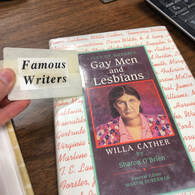 The censorship my student and I discovered The censorship my student and I discovered With lists in hand, the search underway, we scoured the library for the book for her research project. Now, our school library wasn’t large – barely a shoebox of a room, and yet the text eluded us. Right before the bell was to ring, my student approached me. “Mr. Whitman, is this it?” she asked. I looked at the call number: it was, but the title was off. On the computer print off, the title read Famous Writers: Willa Cather. The cover looked to match, but the spine told a different story: Lives of Notable Gay Men and Lesbians: Willa Cather. It was then we realized what we held in our hands: censorship, erasure of LGBTQ+ identities in our school. I decided to liberate this book, take it back out of the closet – for lack of a better phrase. While my student looked for other items on her list, I peeled away the label that some staff member generations before had decided would make this text “school-appropriate.” My colleagues in larger, more diverse school districts may find this shocking, but parts of rural Kansas are still playing the catchup game on diversity and inclusion, a game that many community members would be happy to see our students lose. According to the most recent GLSEN “2019 State Snapshot: School Climate for LGBTQ Students in Kansas” survey, only 52% of LGBTQ students report having inclusive library resources. Worse yet, only 12% reported LGBTQ-inclusive curriculum. In contrast to the 2017 GLSEN Kansas State Snapshot, only 51% of students reported having inclusive library resources; 17% reported LGBTQ-inclusive curriculum. From this two-year difference certain conclusions are clear: representation is stagnant in a best-case scenario in our libraries, but that 5% decrease in classroom representation is undeniable proof that Kansas educators must do better. However, I would be remiss to say that this lack of representation is – as a whole – purposefully malign. The publishing industry only recently started to actively pursue works by LGBTQ+ authors or books that have LGBTQ+ characters and themes; furthermore, tracking and monitoring LGBTQ+ representation in the publishing industry is still in its infancy. The Cooperative Children’s Book Center’s (CCBC) “2017 Statistics on LGBTQ+ Literature for Children and Teens” found that of 3,700 books, 136 (3.68%) had significant LGBTQ+ content, which “includes books with LGBTQ+ primary or secondary characters, LGBTQ+ families, nonfiction about LGBTQ+ people or topics, and . . . ‘LGBTQ+ metaphor’ books.” Some educators may not know where to begin looking for LGBTQ+ texts or what the best texts to include are. Luckily, resources for them are growing by the day, such as the HRC’s Welcoming Schools initiative, Scholastic’s “10 LGBT+ Books for Every Child’s Bookshelf”, Learning for Justice’s “LGBTQ Library”, the lists at LGBTQ Reads, and the Rainbow Library. Nevertheless, I know that fighting for a diverse curriculum, let alone diverse library, is also a challenge that educators and librarians face. This comes from personal experience. When I first joined my former district, the librarian and I attempted to order a slew of award-winning books that also reflected diverse communities, including those of sexual orientation and gender identity: purchase order denied. Yes, something is rotten in the state of education and literacy, and the pattern is undeniable when looking at the American Library Association’s “Top 10 Most Challenged Books of 2019”. Can you spot the pattern? 1. George by Alex Gino 2. Beyond Magenta: Transgender Teens Speak Out by Susan Kuklin 3. A Day in the Life of Marlon Bundo by Jill Twiss, illustrated by EG Keller 4. Sex is a Funny Word by Cory Silverberg, illustrated by Fiona Smyth 5. Prince & Knight by Daniel Haack, illustrated by Stevie Lewis 6. I Am Jazz by Jessica Herthel and Jazz Jennings, illustrated by Shelagh McNicholas 7. The Handmaid’s Tale by Margaret Atwood 8. Drama written and illustrated by Raina Telgemeier 9. Harry Potter series by J.K. Rowling 10. And Tango Makes Three by Peter Parnell and Justin Richardson, illustrated by Henry Cole Did you figure it out? If not, here’s an overly simplified breakdown. Americans are terrified of their children becoming one of four things: gay, feminists, witches; or gay, feminist witches. Jokes aside, these challenges come from our communities. The most frequent reasons for seeking to ban seven of these ten books? LGBTQIA+ content. Moreover, 43% were banned specifically because of content on trans or gender identities, and 43% were banned due to conflicts with religious or “traditional” family values. Some bans even continue to perpetuate the harmful myth that LGBTQIA+ identities are an illness, sin, or something into which children might be indoctrinated: 43%. I’ve seen this myth – one debunked by the Southern Poverty Law Center – perpetuated in many schools and communities. Furthermore, the American Academy of Pediatrics all agree with research: people do not choose to be LGBTQ+, and it is caused by genetic and environmental factors. This includes gender identity. When students have asked me or the counselor for LGBTQ+ books, we’ve helped them find copies of age-appropriate texts, but sometimes we receive the books back from home with a note that the child shouldn’t read it because it may turn them gay, or that the family doesn’t approve of the content on religious reasons. I’ve even had parents express concern that I was teaching Walt Whitman and Emily Dickinson through a queer analytical perspective. Have you read much of Whitman’s poetry or Dickinson’s letters to Susan Gilbert? If you’ve ever read anything beyond Whitman’s American nationalism and Dickinson’s death or religious poems, they’re pretty gay. Just as reading from the perspective a person of color’s experience won’t turn a child into a different race, reading the perspectives of a queer person or considering classical class texts through a queer lens won’t turn a child gay. But, I can tell you one thing it will do: it will help them build empathy. It will help them understand others – people not like them. And, if I’m lucky, some may see themselves reflected. To be frank, there is nothing wrong with coming from a religious family or one that has “traditional” family values. Those are my roots. What is wrong is when religious communities and families want to create a parochial school in a public institution by censoring texts and curriculum. Public schools serve just that: the public. Everyone. Even LGBTQ+ people. Plenty of texts in the ELA canon feature nuclear “traditional” families or heterosexual relationships (Romeo & Juliet, To Kill a Mockingbird, The Great Gatsby, The Hunger Games, The Odyssey, Pride and Prejudice, Sense & Sensibility, A Tale of Two Cities, Their Eyes Were Watching God – all say, “Hello!”); many feature or reference Judeo-Christian ideas, morals, and philosophies (A Christmas Carol, The Crucible, The Scarlet Letter, Dickinson’s religious poems, and nearly any early-American text in a junior English textbook also say, “Wassup?”). What we are not asking for is their erasure: we are asking for our equal representation. If that disturbs you, a school system that represents everyone, here’s a list of private Kansas schools. As a friendly reminder, private education does not always have to provide services to people with disabilities, LGBTQ+ students, or students of color. In short: no federal funding? Fewer protections. 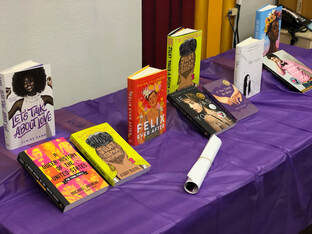 The texts included in my Rainbow Library The texts included in my Rainbow Library While protections are growing for our LGBTQ+ students, there’s still much work to be done, and it starts with the teachers. Often, we make purchases at our own expense, but sometimes blessings come our way, like that aforementioned Rainbow Library. When a representative from GLSEN Kansas posted that this nonprofit collaborative was happening, that I could obtain free LGBTQ+ books for my school’s library, I jumped at the chance. Purchase orders be damned! Willa Cather was going to have company. Upon receiving the texts, I created a display in my classroom, performed a book talk, and I asked each class of students the following questions on an anonymous survey. In total, about 66% of high school students completed the survey, and these were my findings. Question 1: Do any of these books interest you? Why and why not?
Question 2: Should students have access to books like these in a school library or classroom library? Why or why not? Despite religious convictions, 100% of students surveyed thought that the books belonged in a school or classroom library. A few of their most poignant statements are below. Only spelling, punctuation, and capitalization have been corrected for readability.
If only their parents and communities knew their thoughts and the value of these texts to our students. Unfortunately, many students feel they can’t have these conversations with their parents. They fear what might happen: disapproval, conversion therapy, disownment. As we tell our LGBTQ+ students, “It gets better,” we must also remind ourselves that it is getting better, and we teachers can make it better. If I’m certain of one thing, it is this: there is hope for the future, and it’s sitting in my library and in the desks of my students.  About the Author Nathan Whitman is the current Kansas Association of Teachers of English President. He teaches English at Derby High School USD 260 and is also an adjunct professor at Hutchinson Community College and WSU Tech. Twitter: @writerwhitman Instagram: @writerwhitman By Dr. Katie Cramer ***The following post was originally posted on Dr. Cramer's personal blog, which can be found here. In her groundbreaking book Cultivating genius: An equity framework for culturally and historically responsive literacy, Dr. Gholdy Muhammad convincingly argues that Black and Brown excellence has been erased from our curriculums and that contemporary education prioritizes the teaching of basic skills to the detriment of our students, particularly our students of color. To address these significant issues, Muhammad (2020) developed the Historically Responsive Literacy (HRL) Framework based on her research on Black Literary Societies of the early 1800s in which “literacy was not just for self-enjoyment or fulfillment, it was tied to action and efforts to shape the sociopolitical landscape of a country that was founded on oppression” (p. 22). The four pursuits of the HRL Framework The HRL Framework features four interwoven pursuits that also align with those of the Black Literary Societies of the early 19th century:
In her book, Muhammad argues that the HRL Framework is useful in all content areas at all levels. She explores each of the four pursuits in detail and convincingly argues the value of each one. For example, in describing identity development, Muhammad (2020) reminds us that identity was stripped from enslaved Africans and so it is vital that people of color know themselves in order to tell their own stories (p. 64). We must encourage our students to speak for themselves, and we must listen. We must also interrogate and resist our own deficit thinking (e.g., labeling students first/only as “at risk,” “defiant, “unmotivated, “tier 3”), and instead take an appreciative stance toward their existing literacies (Bomer, 2011, p. 21). We must check our (colleagues’) bias when speaking about students who have been and continue to be marginalized in schools. We must listen to Muhammad’s words: “I have never met an unmotivated child; I have, however, ‘met’ unmotivating curriculum and instruction” (2020, p. 65). Indeed, our students’ identity stories must begin with their excellence (Muhammad, 2020, p. 67). Erasure of Black and Brown Excellence Dr. Muhammad convincingly argues that knowledge of Black Literary Societies and Black and Brown excellence has been erased from our curriculums throughout PreK-16, including in teacher education programs. Like Larry Ferlazzo (2020), I am embarrassed to admit that I had never heard of Black Literary Societies before reading her book. She urges teacher educators (those who prepare future teachers) toward the following pursuits:
Exploring the HRL Framework As teachers (at all levels), we must interrogate our own practice using the HRL framework, asking ourselves for each pursuit: “Where is the evidence in my practice?” and “What are my goals for improvement?” To engage in this work, I urge you to review questions for reflection from Dr. Muhammad that accompany each pursuit and consider how you might revise (or design new) lessons/units to fulfill these pursuits—and engage in your own intellectual development by exploring Dr. Muhammad’s work further (see links the list of references below): Identity
Skills
Intellect
Criticality
Friends, we must interrogate our curriculums—the ones we design AND the ones provided by our school districts. As Dr. Muhammad (2021) reminds us, we “have enough genius to do this work.” So let us begin. References Bomer, R. (2011). Building adolescent literacy in today’s English classrooms. Heinemann. Ferlazzo, L. (2020 Jan. 28). Author interview with Dr. Gholdy Muhammad: “Cultivating genius.” Edweek. https://www.edweek.org Muhammad, G. (2020). Cultivating genius: An equity framework for culturally and historically responsive literacy. Scholastic. Muhammad, G. (2021 Mar. 17). Cultivating genius and joy: An equity model for culturally and historically responsive literacy [Webinar]. WRITE Center. https://www.writecenter.org/webinars.html Further reading Learn more about Dr. Gholdy Muhammad by viewing her faculty profile at Georgia State University. For more information on Black Literary Societies, read Cultivating Genius and/or Forgotten readers: Recovering the lost history of African American literary societies (2002) by Elizabeth McHenry, the first chapter of which is available HERE. 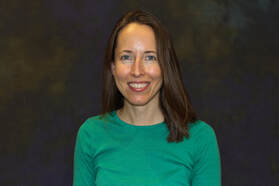 About the Author Katherine Mason Cramer is a former middle school English teacher and a professor of English Education at Wichita State University. She has been a KATE member since 2010 and an NCTE member since 2000. She serves on the KATE Executive Board, and has served as Editor of Kansas English since 2017. She can be reached at Katie.Cramer@wichita.edu. by Michaela Liebst February 1st marks the first day of Black History Month, and with all of the events that have transpired over the past year, the celebration of black culture, influence, and pride feels more important than in years past. As educators, we are given a unique chance to highlight Black voices and bring them to the forefront of our curricular focus, exposing students to new concepts, ideas, and styles that they may have never experienced before. The KATE blog team feels passionately about this endeavor, and wants to aid you in bringing minority voices to the forefront. We are excited to provide a list of novels created by ELA teachers for both elementary and secondary grade levels that represent not only black characters, but other minority groups as well. We believe representation in literature is the key to equity and that creating a culture of understanding and inclusion within our classrooms is essential for helping to ease some of the dissonance that our communities, states, and nation are currently facing. We hope that this list inspires you to consider changing up the books you include in your curriculum, or to spice up your classroom library so that students have more access to a diverse range of books. I also encourage you to check out this blog post by Dr. Katie Cramer regarding the NCTE’s position statements “...to support curricular inclusion…” of all types of diversity. We are aware that combining the beliefs of your district with our nation’s current political climate could possibly deter you from wanting to provide access to these texts. However, we challenge you to start small and use the position statements as a way to advocate for the inclusion of these texts in your school buildings. Overall, we are excited for the opportunity to share this list with you and hope it inspires you to take advantage of this month to shake things up and prioritize the inclusion of all voices in your curriculum. 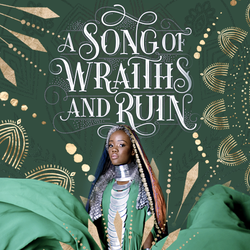 Book Suggestions for Secondary ELA Teachers BLACK HISTORY MONTH A Song of Wraiths and Ruins by Roseanne A. Brown: “The first in a fantasy duology inspired by West African folklore in which a grieving crown princess and a desperate refugee find themselves on a collision course to murder each other despite their growing attraction.” - suggested by Madison Jewell, Middle School ELA Teacher 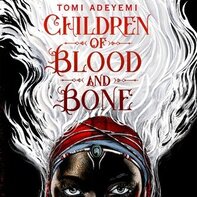 Children of Blood and Bone by Tomi Adeyemi: “The first book in a series about a girl trying to restore magic. The monarchy tries to stop her.” - suggested by Madison Jewell. Ghost Boys by Jewell Parker Rhodes: “A Black boy who was killed by a cop comes back as a ghost along with other black boys unjustly killed to make a difference.” - suggested by Krista May-Shackleford, Elementary Media Specialist 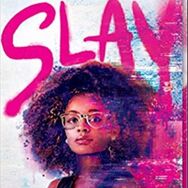 Slay by Brittney Morris: “Slay is a great read—A Black female protagonist has designed a game only open to Black players and keeps her role a secret. Her game has real world consequences and she suddenly finds herself over her head. I’m not a gamer but enjoyed it on so many levels.” - suggested by Lizanne Minerva, High School ELA teacher OTHER MINORITY GROUPS Middle-Eastern Culture -The Wrath and the Dawn by Renée Ahdieh: “Sharazad wants to get revenge on the boy-king who murders his new bride the night they marry. She chooses to marry him but comes to find he may not be like what he seems.” - suggested by Madison Jewell Latinx Culture - Into the Beautiful North by Luis Alberto Urrea: “Into the Beautiful North depicts fun, memorable characters who embark upon the dangerous journey to cross the border into America. This author has a unique way of combining humor, realistic teenage angst, and the serious issue of border crossing that keeps you turning pages and cheering for the heroine and seriously hoping for a sequel!” - , suggested by Deborah McNemee, High School ELA teacher LGBTQ+ - Cemetery Boys by Aiden Thomas: “A trans boy determined to prove his gender to his traditional Latinx family summons a ghost who refuses to leave” - suggested by Madison Jewell 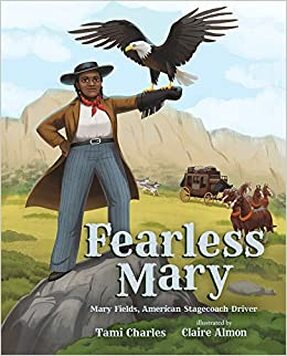 Book Suggestions for Elementary Teachers BLACK HISTORY MONTH Fearless Mary by Tami Charles: “A real-life story that takes you back to the western front and hard dirt trails! Mary was the first woman stagecoach driver – the first African American woman stagecoach driver, in fact! This book shares some of her trailblazing experiences during her journeys carrying much-needed supplies and much-welcomed letters to people who had moved out west! Comic-book style illustrations make for a fun accompaniment to her story, including how her actions have influenced present-day mail delivery!” -suggested by Hannah Kraxberger, an elementary student teacher 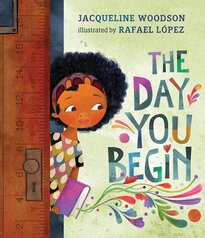 The Day You Begin by Jacqueline Woodson: “The Day You Begin is about a young girl experiencing kindergarten for the first time. She is excited and nervous at the same time! Everyone seems so different. When the students share what they did over the summer, it’s hard for Angelina. She hears of all the wonderful stories of adventures her classmates went on while she stayed home and watched her sibling. Angelina finds her voice to share that she stayed home and, even though she didn’t experience any amazing stories, she MADE stories and that’s okay...Everyone has similarities and differences, and that’s what makes us beautiful!” - , suggested by Hannah Kraxberger CHILDREN W/ DISABILITIES Moses Goes to a Concert by Isaac Millman: “This book encourages the use of sign language throughout and includes accurate, colorful illustrations of how to sign the text. The book also exemplifies more subtle attributes of d/Deaf culture, such as some of the students waving to show their applause. The most admirable trait of Moses Goes to a Concert is the depiction of Moses and his friends as happy children who have typical lifestyles. The book does not focus on their disability as a problem to be fixed, and Mr. Samuels teaches them ways to thrive and enjoy activities in unique ways.” - suggested by Hannah Schoonover, an elementary student teacher Why Does Izzy Cover Her Ears? Dealing with Sensory Overload by Jennifer Veenendall: “This book details how confusing school can feel for a child who has a sensory processing disorder. This book could also help a teacher or parents realize that frequent misbehaviors often have an underlying cause. Classmates of a child like Izzy could better understand the reactions their classmate has and the interventions their classmate uses after reading this book. This book could also help a child with a sensory processing disorder explain how or what they are feeling in certain situations and give them a character with whom they can relate.” - suggested by Hannah Schoonover The Seeing Stick by Jane Yolen: “The Seeing Stick begins with Hwei Min feeling sad that she cannot see and shows her father trying to help fix her disability. However, as the book progresses it shows Hwei Min’s emotional transformation as she becomes comfortable “seeing” with her fingertips. The Seeing Stick gives the message that Hwei Min did not need to be “fixed.” However, she just needed the correct help and tools to allow her to embrace her disability.” - suggested by Hannah Schoonover We’ll Paint the Octopus Red by Stephanie Stuve-Bodeen: “Stephanie Stuve-Bodeen, author of We’ll Paint the Octopus Red, strove to write this book from a child’s point of view on what having a younger sibling with Down syndrome could be like.” -suggested by Hannah Schoonover GENDER A is for Awesome! by Eva Chen: “I really liked this board book about awesome women. I really enjoyed the quotes by Amelia Earhart, Katherine Graham, Queen Elizabeth I, and…you! Each page features an incredible woman and has a quote by her. I really liked that quotes are included, and they are so beautiful! The illustrations will easily capture your reading buddy’s attention and keep yours. It’s primarily for the 0-4 age range, but I think it would be engaging for kindergarten and first grade students, too!” - suggested by Hannah Kraxberger 50 Women in Science by Rachel Ignotofsky: “Fifty women, born from 350 CE through 1977, have their stories and inventions and experiments recorded in this book. You’ve got your (now) well-known Katherine Johnson, Marie Curie, and…SURPRISE! Did you know that Hedy Lamarr, star of Hollywood’s Golden Age, was also an inventor? She’s most definitely more than just a pretty face. Each biography has an illustration of the woman, a quote from her, a small summary of what she’s accomplished, and a full page detailing how and when she made her mark on science. With all that information, it’s definitely not a sit-down-and-read-all-at-once kind of book, but highly worth your time. This book will be in my classroom for sure.” - suggested by Hanna Kraxberger CULTURAL The Proudest Blue by Ibtihaj Muhammad: “It’s the first day of school and Faizah’s older sister Asiya gets to wear the most beautiful deep blue hijab she has ever seen. It’s a big deal because it means Asiya is all grown up now! But Faizah doesn’t understand why some kids at school tease her sister for the hijab. Don’t they know it is an honor? Don’t they see the beauty in it? Written by an Olympic medalist, this book explains the meaning of the hijab to the Muslim faith and to the women who wear it. The colors and illustrations used are eye-catching for the reader (and listener!) to engage with. Moreover, it tells a wonderful story of being brave, resilient, and understanding of differences. “ - suggested by Hannah Kraxberger Same Same but Different by Jenny Sue Kostecki-Shaw: “A tale of two pen pals, this is a book of exploring differences! Elliot tells about his American house. Kailash writes a letter back about how his house in India is different, but also the same! Kailash writes about his pet. Elliot writes back to share about his pet and how it’s different. As the letters go on, the boys find that same and different are things that they share – in a lot of aspects!” - suggested by Hannah Kraxberger We Are Grateful by Traci Sorrell - “This book walks through memories of the Cherokee people using the native word for “grateful” to apply to different situations as a way of remembering the past and celebrating the future. Side note – This was perhaps the first book I’ve had the pleasure of reading that involved Native American tribes in a non-Pilgrim perspective or setting and it was so good.” - suggested by Hannah Kraxberger While we know that this list doesn’t even begin to scrape the surface of all of the incredible books available to teachers, we are excited about this list because it contains books that have been vetted by actual teachers in actual classrooms.
If there’s a book you feel passionately about that should have made the list, comment it below so that we can continue to celebrate and include the voices of both Black culture as well as other minority groups. Happy February and Happy Black History Month! By Deborah McNemee Dear KATE, When we finally rang in 2021, KATE blog committee planned to post a welcome to the new year blog. And then… Well, let’s just say this isn’t the new year post we’d planned. Once again teachers have been handed the dilemma of figuring out how to navigate what life just handed us. Part of the mission of KATE is to provide a forum for dialogue and collegiality among Kansas teachers of English Language Arts and to provide leadership and direction for instruction. We serve all Kansas ELA teachers. ELA is for everyone. It says so on our webpage. We know, however, the challenges of teaching English language arts without touching upon controversial topics. On Patriot’s Day, I always have some kind of memorializing activity. The motto associated with 9/11 is We Will Never Forget. I remember where I was that day. I was locked in the surreality of the rite- of - passage apple orchard field trip with my second grade daughter. She and her friends romped happily through the grounds, picking fruit and pushing each other too high on the tire swing until the teacher came over and told them to stop. It wasn’t safe. All the while, I couldn't help myself from sneaking back to my car for updates on the crumpled towers and decimated lives. I take the 9/11 motto seriously and personally. In order to never forget, it’s the responsibility of those of us who lived through it to pass the memory on to those who weren’t even born yet. As a teacher, the responsibility weighs heavily. So, I do the Patriots Day activity. This year, I showed an inspiring video, ESPN’s The Man with the Red Bandana. The next day, a father of a Muslim student called the school to complain. He felt the subject was too controversial to bring up in class. He never actually contacted me, but when I was told of his concern, I responded with a sincere letter explaining how in AP Lang, that’s what we do. We discuss controversial topics. I apologized for any emotional discomfort and assured him that I do my absolute best to protect my students while also teaching them how to engage in difficult conversations. He must have been appeased because I never heard back. However, that weight of responsibility pressed even harder. On January 6th, teacher social media filled up with educators wondering how to approach students the next day. As one might expect with social media, a lot of people had a lot of opinions on exactly how teachers should handle their students. The KATE Facebook page, however, was silent. At first, I wondered if someone would post something. If someone else would fire back. If the divisiveness might infiltrate our amazing group. It didn’t. But we were silent. And I wondered, too, what the silence meant. Today, I think I have an answer. I think it means we’re okay. I think it means that we completely understand the concept that ELA is for everyone. KATE is a non-political entity, or at least I believe we try to be. Dealing with difficult discussion is an integral part of an English teacher’s job. It’s probably perfectly fine for someone to post on KATE Facebook a suggestion on how to handle the events of January 6th or 9/11 or BLM or any other controversial thing. I would hope we would be wise and open minded enough to react in the way we expect our students to react--with respect and dignity and acceptance of varying viewpoints. But you know what else, I also think it’s perfectly fine that we chose silence. You know that feeling of gathering your warm cat into your lap and snuggling to his muffled purr while the hardness of the world melts away? I think that can be KATE, too. We’re in this together. We know that. The personal connections we make during our book clubs and meetings and conferences run deep. We know someone has our back. That’s my hope, that you know that KATE has your back. If you don’t know that, if you don’t feel you have a KATE member you can reach out to individually, here is a link to our board members. I know they would be happy and honored to offer advice, or a listening ear, or maybe even a purring cat. ELA is for everyone. Be strong. Be well. You are where you belong.  About the Author Deborah McNemee teaches at Andover Central High School where a culture of reading is alive and well. She creates a culture of reading with her students by annually hosting a project based event in partnership with Big Read Wichita. She facilitates a writing culture through encouraging involvement with the NaNowriMo Young Writers Program and submitting student work to Voices of Kansas. Her favorite books to read outside of school are classics. Check out her blog about keeping classics relevant for kids at www.KeepingClassics.com. By Erica Shook 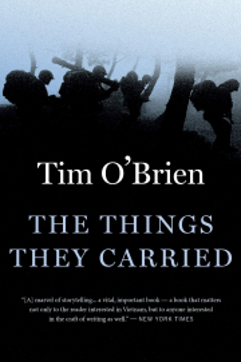 Though I am a vocal proponent of getting more contemporary YA lit. into the hands of our students, I do still enjoy teaching some of the classics. The balance in my classroom has come from connecting classic and contemporary works. For example, after we read Beowulf together in class, students choose from four different contemporary novels that they read together in small groups and then connected back to Beowulf (Kendare Blake’s Anna Dressed in Blood, Moira Young’s Blood Red Road, Marie Lu’s Legend, or Neal Shusterman’s Unwind). As an avid reader, my brain is constantly looking for text connections. And with increasing frequency, I find myself connecting current events to texts as well. The current reality for teachers has caused me to do just that. I have adapted what follows a bit because I originally wrote and presented it to our school board to try to build empathy among them for the load teachers are currently carrying. That is what English teachers do, right? Use writing and books to build empathy? The message, however, remains the same. Much like the soldiers in Tim O’Brien’s book The Things They Carried, what teachers carry is partly a function of experience, partly a function of specialty, and partly born of necessity. We carry a veritable rainbow of Expo markers--some that work well, some that we are trying to squeeze the last bit of ink out of; notebook paper; construction paper, printing paper, butcher paper, card stock, poster board; glue; scissors; duct tape, scotch tape, masking tape, painters tape, packaging tape, book repair tape; lab supplies; paper clips; pencils, pens, markers, sharpies, crayons, colored pencils; paint; bulletin board border; rulers; kleenex; band aids; Post-it notes; keys; white out; rubberbands; staplers; index cards; note cards; popsicle sticks; candy; books, books, books; computers, charging cords, cables; granola bars; crackers; chocolate; hand sanitizer, Virex, masks; gallons of coffee; water bottles with times on the side to remind us to stay hydrated; stacks and stacks of papers to grade; and, Flairs in every color. I won’t bore you with the precise weight of each of these items, but know that combined, these things are heavy--and we probably paid for most of them out-of-pocket. As with O’Brien’s characters, the things teachers carry, though, are both literal and figurative. We also carry the professional development that we don’t have time to work with and implement; field trips we can’t experience; technology that doesn’t always work; lesson plans that implode because they were better on paper and have to be reworked on the spot; our own families that don’t always get our full attention when we are at home; dusting, laundry, and dishes that sometimes pile up; continuing education credits; students in our classrooms who struggle (both academically and emotionally) but whom we don’t have time to work with one-on-one; hundreds of decisions every hour--many of them split second; students who are suffering because of bullying; students who are hungry or tired; students who are neglected or abused; students who have lost loved ones or friends; students who feel they can’t share their true identity; students who rarely see themselves reflected in curriculum; students’ failures; students’ successes; students’ smiles; students’ tears; students who have been lost in accidents; students who have contemplated suicide; students who have taken their lives before they’ve really had a chance to live them; and, more love than any human heart should be able to hold for every single one of them who ever passes through our doors. The weight of these things is incredibly heavy. Sometimes almost unbearably so. But we carry it because we love what we do, and we love our students. It genuinely is who we are. But this year, we also carry the weight of students in the classroom and at home with technology that glitches or crashes; catching up students who missed class or missed parts of instructions because of those glitches and crashes; students and staff in quarantine; finding ways to provide equitable opportunities to in-person and remote students alike; students embarrassed to turn on cameras or too shy to unmute microphones; lost instruction time for more sanitizing; the endless, endless emails; the extra prep needed to make sure students at home have the materials they need ahead of time to actively participate in class; time spent converting curriculum to digital versions of itself; learning new tools to do so; needing to collaborate with colleagues with no time to do it; building the relationships and giving the hugs our students need while maintaining social distancing to keep everyone healthy and at school; knowing social-emotional needs are not being met; understanding why some of our students have chosen remote learning but missing having their masked faces in class with us; helping our own children be successful with their learning; the overwhelming guilt for the things we know are necessary but are beyond our ability to do; balancing it all; balancing the emotions; the all-encompassing exhaustion; and listening to one person after another tell us we can’t pour from an empty cup when we rarely have a chance to fill it or suggesting what we need is to take a mental health day with no understanding that the things we carry never get lighter for having done so--it just buys us a bit more time before we collapse under the physical, mental, and emotional weight. Kansas is already experiencing a teacher shortage it will take years to get ahead of, and many more will leave the profession this year, maybe even at the end of this semester, because of the toll the weight of the things they carry is taking. I am concerned for Kansas teachers and the sustainability of our situation. I wonder, as the decision-makers in districts are meeting, whether they have gotten into classrooms to experience the current teaching reality? I don’t mean walk-throughs. I mean, have they spent entire class periods or days in multiple content areas to truly understand the new workload? I want anyone who reads this to know I see you--KATE sees you--and we know how hard you are working for your students. KATE is thankful all year long for Kansas teachers, the magic they bring into their classrooms every day, and the passion with which they teach Kansas students. My hope is administrators, school board members, legislators, and other decision-makers keep in mind the immense weight of the things our teachers carry. 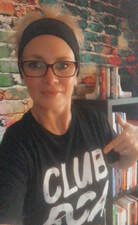 About the Author Erica Shook is the English Department Chair at McPherson High School, USD 418, and a 2020 LEGO Master Educator. Because of her passion for students, educators and education, ELA, YA literature, and social activism, she is also a Project LIT Community chapter leader, LiNK Adolescent Lit. CoP Leader, and the KATE Vice-President. Follow her on Twitter at @Ms_Shook or on Instagram at @ms_shook for book suggestions to build classroom libraries or for continued professional development. 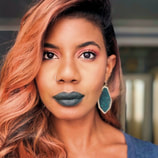 This year, KATE is pleased to announce that on November 7th at 2 p.m., Nic Stone, author of the New York Times bestseller, Dear Martin, will deliver a virtual keynote address followed by a Q&A session, available to all KATE members as our gift to you for your continued support and dedication to teaching English in the state of Kansas. Nic Stone is an Atlanta native and a Spelman College graduate. After working extensively in teen mentoring and living in Israel for several years, she returned to the United States to write full-time. Nic's debut novel for young adults, Dear Martin, was a New York Times bestseller and a William C. Morris Award finalist. She is also the author of the teen titles Odd One Out, a novel about discovering oneself and who it is okay to love, which was an NPR Best Book of the Year and a Rainbow Book List Top Ten selection, and Jackpot, a love-ish story that takes a searing look at economic inequality. Clean Getaway, Nic's first middle-grade novel, deals with coming to grips with the pain of the past and facing the humanity of our heroes. Nic lives in Atlanta with her adorable little family. In lieu of this exciting keynote speech, KATE wanted to provide its members with a little preview of Nic's personality and flair. Cue a hilarious and telling game of "Would You Rather...?" between the author and KATE's VP, Erica Shook. Please enjoy the following tidbits that Nic was so gracious to share with us, and we hope you'll join us on Saturday! Shook: Ok, Nic. Would you rather:
Potter or Snape Stone: SNAPE ALL DAY EVERY DAY. Shook: Know it all OR Have it all? Stone: Definitely have it all. Knowledge can be burdensome. Shook: Talk like Yoda OR Breathe like Darth Vader? Stone: Like Yoda, speak I would. Shook: Be a superhero OR Be a famous singer? Stone: I am CLEARLY both. Tuh. Shook: Go to work OR Stay home and bang on drums all day? Stone: Drums. Shook: Be transported to a place and time of your choosing in the past OR Be transported to a random place and time in the future? Stone: Def place and time of my choosing in the past. Shook: Steal honey from a bear OR Steal honey from a beehive? Stone: I'll take the bear. Shook: Be 50% good at everything OR Be 100% good at one thing? Stone: 100% good at loving people! Shook: Jump into a pool of lava OR Jump into a pool of freezing water? Stone: I mean I die either way, so... Shook: Be stuck inside on a good day OR Be stuck outside on a bad day? Stone: Inside. Sleep is always an option. Shook: Be color blind OR Have no taste buds? Stone: Yeeks... color blind. Shook: Always say everything on your mind OR Never speak again? Stone: Always say everything. (These are brutal.) Shook: Have the power to read minds OR Have the power to read hearts? Stone: I wanna read hearts. Shook: Fight 100 duck-sized horses OR Fight 1 horse-sized duck? Stone: 1 over 100. Even though a horse sized duck sounds terrifying. Shook: Live in a space station OR Live in a deep-sea submarine? Stone: Space station! Shook: Pop OR Soda? Stone: Eww neither. Coke. Sprite. Fanta. Pepsi. CALL IT BY ITS NAME. Shook: Chili and cinnamon rolls OR Chili and cornbread? Stone: Cinnamon rolls. #dessert Shook: Lose the ability to read OR Lose the ability to write? Stone: How dare you! Not choosing. So there. Shook: Lipstick OR Earrings? Stone: This is getting worse and worse. (Earrings.) Shook: Lipstick OR Shoes? Stone: And here I thought we were friends. Smh. (Shoes.) Get registered if you haven’t already. You are not going to want to miss KATE in conversation with Nic Stone. See you all Saturday! Erica Shook, KATE Vice-President |
Message from the EditorWelcome! We're glad you are here! Archives
March 2024
Categories
All
|
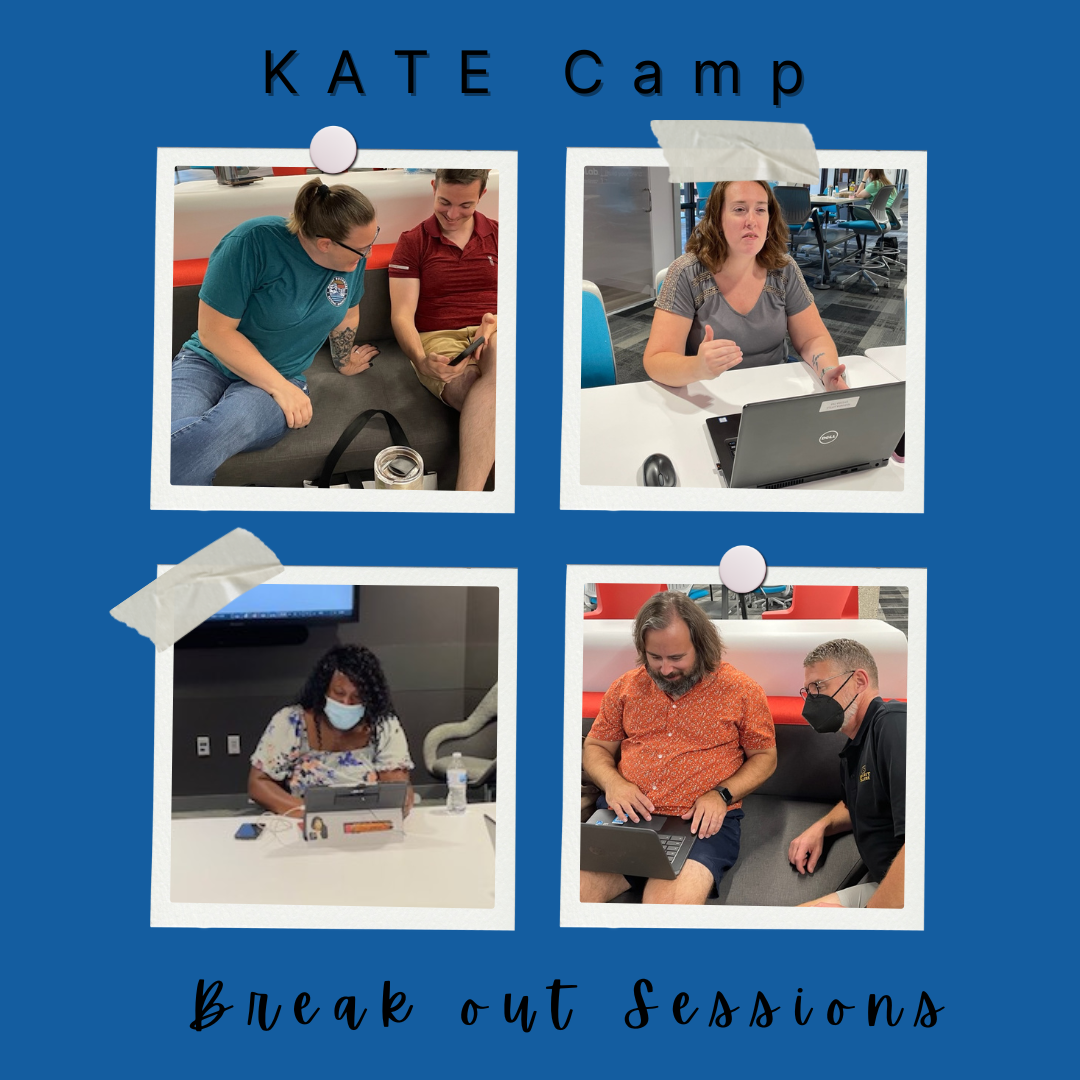
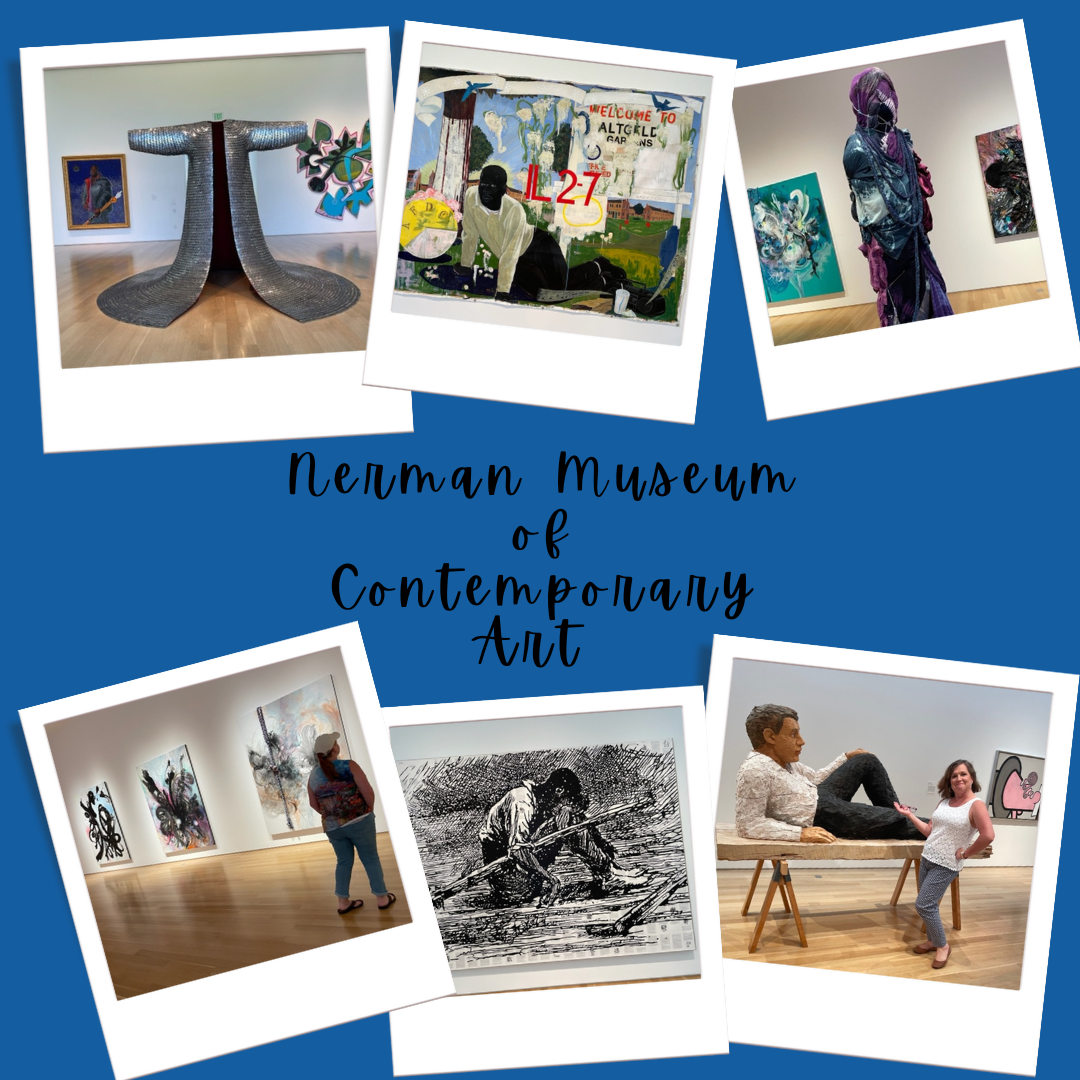
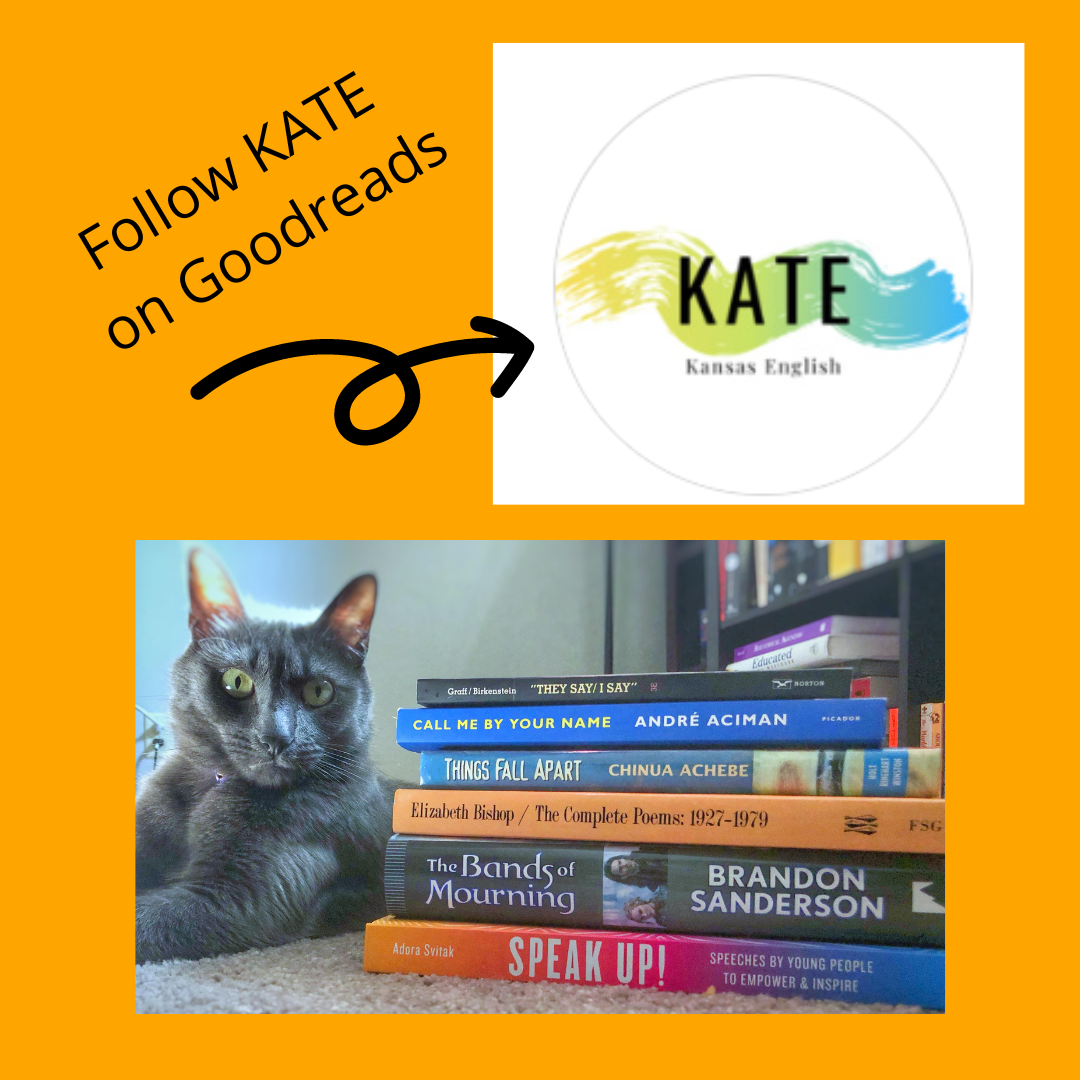
 RSS Feed
RSS Feed